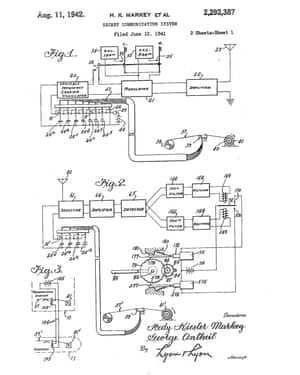Hedy Lamarr – the 1940s ‘bombshell’ who helped invent wifi Pamela Hutchinson
https://www.theguardian.com/film/2018/mar/08/hedy-lamarr-1940s-bombshell-helped-invent-wifi-missile
The actor, who depicted film’s first female orgasm, was well known for her scandalous love life and sultry beauty. Now, a new documentary explores how her scientific talents were vastly overlooked.
Hedy Lamarr, the star MGM called “the most beautiful woman in the world”, had two of the worst-kept secrets in Hollywood. One of them, she could never escape until long after her career was over. The other, the press took little interest in at the time – but since her death in 2000, this is the story that has come to define her. A new documentary about Lamarr’s life, released this weekend, encapsulates both stories – one about sex and the other about science – in the innuendo of its title: Bombshell. Lamarr’s story is one of a brilliant woman who was consistently underestimated. It also gives us the clearest possible illustration of why on-screen representation matters – of all the parts that Lamarr was given to play, none of them was as fantastic, or inspirational, as her real life.
The actor, who was born Hedwig Kiesler in Vienna in 1914, was given her new surname by Louis B Mayer when she signed for MGM in 1937. He named her after the studio’s silent-era vamp Barbara La Marr – intending that her dark, heavy-lidded beauty should remind people of MGM’s sizzling back catalogue, not her own. Back in Europe she had made a film that was too hot for MGM’s family-values ethos. Gustav Machaty’s Ecstasy (1933) starred a teenage Hedy as a frustrated bride who finds fulfilment in an affair with a young man: she appears completely nude and performs what is probably the first on-screen female orgasm. Lamarr herself said that her movements in the love scene were prompted by the director shouting instructions and sticking her with a safety pin, but the effect, in this atmospheric, heavily symbolic and near-silent drama, is remarkably intense. The film was banned in the US, but screened illicitly there for years, and no matter how many hits she had at MGM, and despite the studio’s efforts, Lamarr was frequently referred to as the “Ecstasy girl”.
Although she achieved international fame as a Hollywood movie star, Lamarr was not satisfied by acting. In her trailer between takes, and staying up all night at home, she practised her favourite hobby: inventing. In an audio recording used in Bombshell, she discusses her love of science, her failed experiments (effervescent cola tablets) and her successes, including streamlining her lover Howard Hughes’s racing aeroplane. “I don’t have to work on ideas,” she says. “They come naturally.”
Lamarr’s greatest scientific triumph was intended for the US navy during the second world war, but is now used in modern wireless communication. Her “secret communication system” used “frequency hopping” to guide radio-controlled missiles underwater in a way that was undetectable by the enemy. It was Lamarr’s brainwave (though some say she may have first seen a sketch of a similar idea in the office of her first husband, the Austrian munitions manufacturer Fritz Mandl) and she developed it together with a friend, the composer George Antheil. The patent was granted in 1942.

The military took her idea and, as the documentary reveals, eventually used it, but Lamarr was advised that she would make a greater contribution to the war effort as a pinup rather than as an inventor: entertaining troops, pushing war bonds and, as the documentary notes, selling kisses. Lamarr’s invention didn’t become widely known until near the end of her life, in the late 1990s. It gained more traction when her obituaries were published in 2000. Since then the news has spread and she has become an icon of women in science – in comic books, plays and even that modern monument, a Google Doodle.
All the time that Lamarr was making big films in Hollywood (and missing out on even more, including Casablanca and Gaslight) the press kept writing about her love life (six marriages and six divorces), and her sultry, kittenish looks. Anything but her invention – despite the fact that it had actually been made public in 1941. The National Inventors Council leaked the story to the press, leading the LA Times to call Lamarr a “screen siren and inventor … [whose] invention, held secret by the government, is considered of great potential value in the national defense program”. The story disappeared and by 1944, when Motion Picture Magazine referred to Lamarr’s intelligence, it was talking about her “discovering a new headdress”. As Lamarr aged, she became a joke – even the ghostwriter of her memoirs turned them into something so “fictional, false, vulgar, scandalous, libelous and obscene” that she sued the publishers.
Lamarr’s biggest movie roles, from Samson and Delilah to Ziegfeld Girl, White Cargo and Experiment Perilous, prioritised display over action – her characters, often exoticised in a nod to her European heritage, were beautiful creatures to be looked at, absorbed by the male gaze, and with very little to say. Lamarr herself, who pointedly defined glamour as standing still and looking stupid, understood all too well why no one wanted to hear about her science work – it didn’t fit MGM’s marketing narrative.
The credo of the Geena Davis Institute on Gender in Media is “If she can see it, she can be it”, and there can’t be a clearer example than Lamarr’s of why on-screen representation matters. If Lamarr’s full story had been told while she was still working, or if she had ever played a woman as brilliant as herself in a film, perhaps the revelation that a star had brains as well as beauty wouldn’t be quite such a, well, bombshell.
Bombshell is out on Friday.
Comments are closed.
